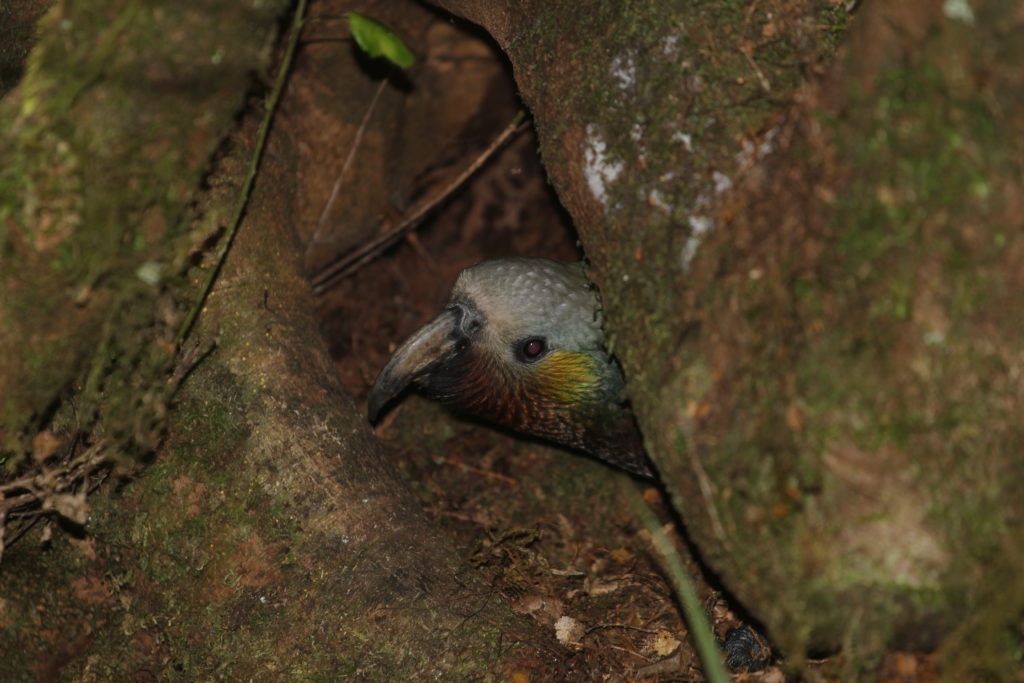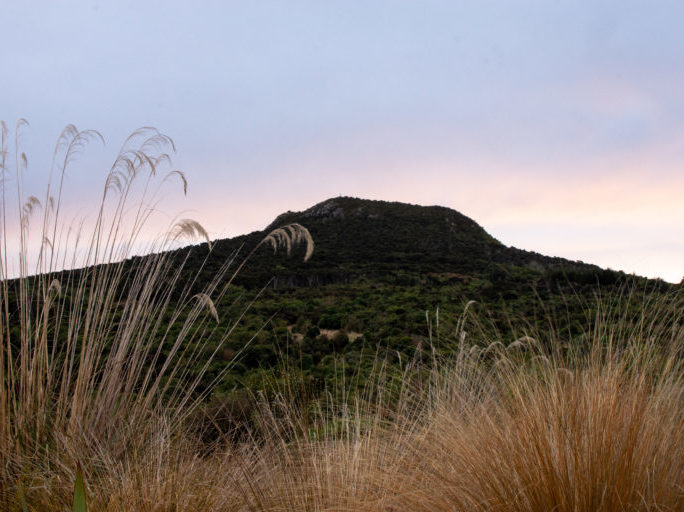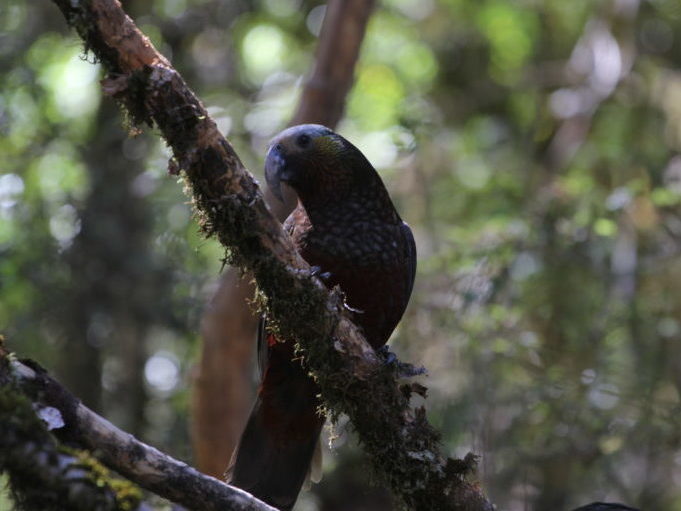Otago University zoologists Anna Aichele, Philip Seddon and Yolanda van Heezik have been measuring the sugar intake of kākā at Orokonui Eco-sanctuary just north of Dunedin where sugar water feeders regularly entice birds down from the trees to the delight of visitors.
Note: We are re-sharing our articles. This article was originally published on December 17, 2020.
It’s a great way to bring the birds closer – but do the kākā benefit from the supplementary feeding or might it be upsetting the nutritional balance of their diet?
“Supplementary food is provided to native birds in eco-sanctuaries throughout New Zealand to discourage their movement outside the sanctuary, to enhance reproductive success, and to promote visitor encounters with wildlife. In New Zealand, supplementary feeding has been used to increase body mass and breeding activity in kākāpō (Strigops habroptilus), while reproductive success of reintroduced populations of stitchbird or hihi (Notiomystis cincta) has been improved through supplementary feeding.”

If birds are struggling with natural food supplies, the extra intake can give them a boost, but there can be unexpected consequences too.
“Supplementary feeding can cause unanticipated consequences, including winter range expansion, altered behaviour (i.e. loss of fear of human presence), decreased migration tendency, reduced dispersal of juveniles, skewed sex ratios leading to depressed productivity, increased nest predation and increased disease transmission. Feeder-dependence has also been suggested as a potential negative impact of food provisioning.”
Supplementary feeding can, however, help to keep native species within the safety of a fenced ecosanctuary, since they have less need to go beyond the boundary to find food. It also gives sanctuary visitors a closer encounter with the birds, since bird activity centres on the feeding stations.

“An example is the supplementary feeding of South Island kākā (Nestor meridionalis meridionalis) in Orokonui Ecosanctuary, Dunedin. Kākā have a varied diet of leaves, fruit, berries, sap, insects, pollen, and nectar. They do not regularly breed, because their reproductive cycle is linked to food availability. Kākā are supplemented with two different types of food in Orokonui; pellets and bottles of sugar water are provided at four locations. This research was focused on the sugar water feeders: the aim was to determine which kākā visited the feeders, the frequency of visits by individual kākā, and the amount of sugar water consumed, in order to determine the extent to which sugar water contributed to kākā daily energy requirements.”
Orokonui is a 307-hectare, fenced sanctuary. Since 2012 it has been free of mammalian predators other than a small number of mice. The kākā population is estimated to be around 40 colour-banded individuals.
“Within the sanctuary there are four wooden feeding platforms, about 1.5 m high and located at least 20 m apart, where solid food (Harrison’s High Potency Coarse Pellets) and sugar water is provided. Feeding has taken place since 2008. No more than two sugar water bottles are provided at each of the four feeding stations, the first at about 10 am. The bottles are not topped up. Each platform has a rain cover: the solid food is contained within a metal feeder that has an opening mechanism designed specifically for kākā, and the sugar water is provided in two one-litre bottles with a metallic head. It is not possible to record how much solid food is consumed as the heads of the kākā are out of sight when they are using the feeder.”
Sugar water is made by mixing 240 grams of white sugar with 2 litres of tap water. Bottles are cleaned, disinfected, and refilled daily. The feeding platforms are also cleaned daily to prevent disease.
The researchers installed four trail cameras during winter 2018 (May and July), one at each feeder, and the activity of kākā was video-recorded during the day.
“Video and the trigger and movement sensors were set to record as soon as a bird arrived on the platform. The cameras were in place for a total of 81 days. Under low light conditions the cameras switched to black and white mode, meaning that identification of birds from colour bands was impossible.”
“From the video footage, we could identify kākā with bands that visited the feeders. We defined arrival time as the moment when a bird touched the platform with its feet and leaving time when the feet lost contact with the platform. Kākā without bands could not be identified and videos of these individuals as well as those where the band could not be read were discarded. Thirty-one individual kākā were identified during this study.”
Kākā don’t drink continuously. They pause occasionally to take a breath and this was factored into measurements and calculations.
“Since it was not possible to measure directly the amount of sugar water consumed by kākā at the feeding platforms without repeatedly frightening birds away, we obtained measurements that allowed us to relate time spent drinking to the amount of sugar water consumed by measuring the drinking time, the amount of sugar water consumed, and breathing interruptions (frequency and duration), in a controlled aviary environment on three juvenile kākā of unknown sex. In the aviary we provided kākā with sugar water feeders containing known volumes of water and concentration of sugar. An observer recorded the exact time of drinking and the number of breaths taken. As soon as the birds stopped drinking, we measured the volume remaining. A total of 18 separate observations of drinking were obtained.”
A total of 31 individual kākā, plus an unknown number of unmarked birds, visited the feeding platforms: 16 juveniles (less than one year old), eight sub-adults (1–4 years old) and seven adult birds (over 4 years old).
“The mean estimated daily consumption of kilojoules per bird was 4.01 kJ ± 3.30 (SD), with values ranging between 1.28 kJ and 14.44 kJ. When expressed as a proportion of each individual’s energy requirements per day, the mean value was 0.76 ± 0.62% (SD); values ranged from 0.24 to 2.74%.
So sugar water isn’t making up a huge percentage of the birds’ energy intake – 2.74% at the most and often much less than that.
“Given the estimated population of kākā in Orokonui is about 40 banded birds, 60% of banded kākā and an unknown number of unidentified birds visited a feeding platform during the duration of this study. We found no evidence that supplementary feeding of sugar water leads to nutritional problems or dependency on sugar water because individual birds spent very little time drinking sugar water and the energy consumed was a very small proportion of their daily energetic requirements. Even after calculating the maximum possible volume of sugar water consumed (by using the upper confidence interval of the regression equation), the mean proportion of the daily energy requirements met by the sugar water was still less than 1%. The highest values were found in juveniles, but this only represented about 2.7% of a bird’s daily energy requirements.”

So Orokonui’s kākā are getting the majority of their daily energy by foraging for food elsewhere and haven’t become dependent on sugar water.
“While neither age nor sex affected the time individual kākā spent on feeding platforms and the time they spent drinking, there was a non-significant trend for juveniles to spend slightly more time on the platforms. Moreover, > 51% of the 31 identified kākā using the feeders were juveniles, and the four individuals that consumed the most sugar water were also juveniles. The feeders may be an easy food source to access when juveniles are learning how to find food for themselves.”
“In our study the sample size of adults and sub-adults was low, possibly because they spend time outside of the eco-sanctuary during winter, or because they are uninterested in visiting the feeders. Even though sap and nectar are important food sources in the diet of kākā and sugar water has a similar energetic value to nectar, availability of food in and around the eco-sanctuary must have been sufficiently good that kākā did not rely on sugar water.”
Supplementary feeding at Orokonui is successful at improving the ‘visitor experience’ of encounters with kākā without creating a dependency on the sugar water.
“While it is carefully controlled with rigorous cleaning procedures, ongoing monitoring should test for the incidence of pathogens in the feeders and the birds visiting the feeders, as well as behavioral changes that could be detrimental to the population growth of this endangered species,” the researchers advise.
They also point out that the contribution of the solid food to kākā total energy intake is not known and is difficult to measure.
“Supplementary food is certainly effective at providing opportunities for visitors to see this threatened parrot species, as well as other native birds that regularly visit feeding stations, facilitating environmental education. Given the dominance of juveniles at the feeders at the time of year sampled, further research is necessary to ensure a better understanding of seasonal variations in supplementary food intake.”
The full research article is published in the New Zealand Journal of Ecology and is freely available online.
Intake of sugar water by kākā in Orokonui Eco-sanctuary (2020)

